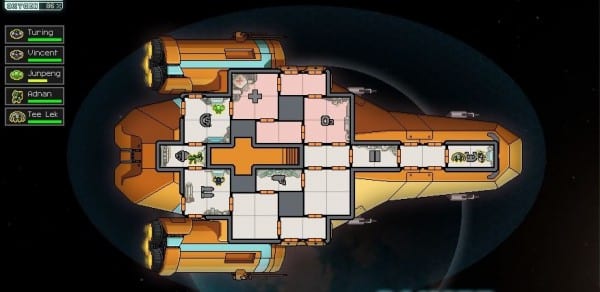
FTL: Faster Than Light is one of Kickstarter’s major success stories. Originally a mostly-finished game looking for a final stretch of funding, it surpassed its goal of $10,000 considerably – ultimately clocking in at just over $200,000. Billing itself as “a spaceship simulation roguelike-like” whose aim is “to recreate the atmosphere of running a spaceship exploring the galaxy”, FTL finally hit Steam this weekend, and I’ll admit to snatching it up immediately. Roguelike-like spaceship simulation exploring a galaxy? I’m hooked. Hell, I was hooked at the word “roguelike”. If any of that description sounds interesting to you, you’ll want to see this review as I highlight what the guys at Subset Games have delivered.
The story FTL throws you into is best summed up with the words “bare basics”. You start out controlling the Kestrel in the service of the vaguely named Federation. There’s a civil war going on, and the (presumably evil) rebels are currently wreaking havoc across the Federation’s territories. Having just acquired some vital information that could turn the tide of the war, your task is to get to the Federation fleet before the pursuing rebels overtake and destroy you – and to do so without losing your ship to any of the other various threats that fill the stars. If you manage to get through to the eighth and final star system, you meet up with the Federation fleet only to be tasked with destroying the boss ship of the rebel’s forces.
With that literary backdrop in mind, let’s talk about the gameplay of FTL. Always on-screen is a cross-section view of your ship, with said ship’s various rooms labeled according to what engineering system or subsystem they’re dedicated to. Initially you’ll start out with a room each for your weapons systems, engine, shields, pilot deck, life support systems, door control, sensors and medical bay. Each of these plays a vital role for your mission and your crew. For instance, your life support systems keep the oxygen flowing in your ship – and if these go offline for too long, your ship’s oxygen will deplete (represented by a reddening of the particular room oxygen is lacking in), slowly draining your crew’s health until they’re dead. If your weapons systems control your ship’s guns, and if these are taken offline you’ll be a sitting duck for any hostile ship until they’re repaired. In addition to all of these systems and rooms is the ship’s hull itself – think of it as your hit points in FTL. While any damaged system can in principle be repaired by your crew, your ship’s hull can only be repaired at a friendly station/’store’. It’s possible to recover from, say, offline life support systems if you move fast enough, but you cannot recover from a completely destroyed hull – if that takes place, game over.[singlepic id=8984 w=320 h=240 float= right]
In addition to maintaining your ship’s various systems, you’ll also have to take care of your crew in FTL. Crew can be assigned to specific rooms to grant a passive bonus to some of the systems on your ship – having a crewman in the weapons system room will make your weapons charge up and fire faster, while placing a crewman in the engine room will give your ship a bonus to its dodge chance. Not all systems have bonuses of this kind, but the ones that do are clearly marked. In addition to these tasks, you’ll need to use your crew to deal with the ravages of space conflict – putting out fires caused by combat, repairing damage to particular systems and subsystems, or even fighting off hostile NPCs who board your crew (or who are on the ship you’ve boarded!) These crew get experience over time in the specific tasks you assign them to, and they are not easy to come by in the game – and if they die, you can’t resuscitate them. Micromanaging crew, ordering them to the med bay to heal up, damaged systems to conduct repairs, fires to extinguish, hostiles to attack or systems to oversee comprises the crux of the game. Also of note is the fact that crew come in a small variety of races – I’ve discovered 5 other than human – which each have their own unique traits to pay attention to, making some more suitable for particular tasks.
In addition to taking care of your ship, you also have to destroy the various hostile ships you encounter. These ships have their own rooms and (unless automated) crew and systems, and if your sensors can detect them, you can target particular systems during combat. For example, maybe you’ll want to focus on their shields to leave them defenseless, or their weapons systems to temporarily defang them altogether. You can even get inventive and shut down their life support, hoping to asphyxiate their crew to eradicate them without even needing to destroy their ship altogether. While simply taking out weapons systems and blasting through an enemy hull tends to be effective, FTL allows for various ways to deal with an enemy threat – complete with achievements for emerging victorious in particularly roundabout ways. If you’re doling out a particularly harsh beating, a ship may even offer you some loot in exchange for letting them simply run off with their metaphorical tail between their legs.[singlepic id=8983 w=320 h=240 float= left]
FTL also offers a few other twists to keep in mind. For instance, all rooms on your ship are connected by doors – including airlock doors. If a fire breaks out in a section of your ship, or some hostiles have boarded and are in a particular section, you can (as long as your aforementioned door systems are online) open the doors to the airlock and suck the oxygen out of the affected rooms, slowly suffocating fires and invaders alike. The various systems also require power in order to function, and you’ll often find yourself rerouting power from one system to another as the situation warrants – for instance, if no one requires healing, maybe you’ll want to shut down the med bay to free up power to place another weapon system online. FTL also uses a combined money and experience pool in the form of scrap which can be used to repair your hull at stations, buy new weapons and subsystems, or used to improve the native systems of your ship. Spend your scrap wisely, because you’ll often find yourself wishing you had more of it in various situations.
On top of all of this is FTL’s exploration aspect. Your route to the Federation fleet will require you to navigate your ship from jump point to jump point, where you’ll encounter friends and foes – but mostly foes. The situation will be explained to you briefly with some text, sometimes allowing you to make various choices of how to deal with whatever confronts you. Combat is always single ship versus single ship, though certain environment effects (such as asteroids or solar flares) may present an environmental hazard to you. Further, FTL does not allow you to explore at an altogether leisurely pace: each jump you make is time spent, which in turn allows the swarming rebel fleet to occupy more and more of the map. If you get caught in the rebel fleet’s swarm, every jump will have you facing off against a powerful hostile ship – which means you have to think strategically about which areas of the map you’ll visit, and which you’ll write off. As you exit each system, you’ll also typically be given a choice as to which of two systems you’ll choose to fly to next, with both presenting their own challenges. Choosing a pirate system over a civilian system, for example, may be more dangerous – but it also may yield more opportunities for coveted scrap.[singlepic id=8982 w=320 h=240 float= right]
With the fundamentals laid out for you, let’s turn attention to the gameplay itself. First, billing itself as “Roguelike-like” is apt, in one particular sense: in FTL, you die. In fact, you die quite a lot. While the game has an “easy” setting, even there you shouldn’t expect a cakewalk – dying is part of learning, and none of the experience or accomplishments you achieve in one game will carry over to your new game, save for the achievements and unlocked ships. The controls are quite well-done – the fact that you can press space to pause the game at any time is a major boon – though clicking on doors in the middle of a firefight can be a bit of a chore. Altogether, considering how unique the game is – there are few titles around like it – FTL has a great feel and look to it. One downside for some may be the graphics, and while I personally love the pixel graphics style, others may wish for some flashier visuals than the game provides.
One thing that FTL, like most roguelike-like games, relies on is replayability. Sure you may die, but the game is supposed to offer you reasons to keep coming back again and again – new experiences, new ways to die, new victories to have and more. In that sense, FTL succeeds – but not overwhelmingly. After a few hours I started to feel as if I’d already seen most of what FTL could truly offer in terms of new experiences, but the game is unique enough that this didn’t dissuade me from coming back to play again. It helps that this is a game that you can truly spend thirty minutes or an hour playing completely – it’s perfect for short little bits of fun, rather reminiscent of a sci-fi Desktop Dungeons. Like Desktop Dungeons, FTL also features an assortment of unlockables by completing per-ship missions and achievements. These ships and their alternate layouts start the game with different assortments of crew and equipment, making the initial rush to your final destination a bit more diverse, and it gives you something to shoot for.[singlepic id=8978 w=320 h=240 float=left]
Finally, one personal gripe: there are eight systems to fly through in FTL, with the final system being the one where you have to face off against the big boss of the game. The problem is that, even on easy mode, it feels as if there’s a disconnecting jump in difficulty between the second to last and last system. While the game certainly get used to dying repeatedly, the sensation of the odds suddenly being majorly stacked against you is a bit of a letdown, especially since failure means starting all over again. In the grand scheme of things it’s a minor gripe with the game, but one that stood out to me on multiple playthroughs.
With all that in mind, FTL remains a great game – not perfect, not legendary, but a great indie title that offers up something pretty unique as opposed to a cheaper version of a game that mainstream devs already do and do better. Pick it up on Steam if you’re interested – as of this writing the game is 10% off and available for $8.99 USD. Happy hunting!
Victor Grunn has been a gamer since the days of single-button joysticks and the Atari 800XL. When not lamenting the loss of the Ultima series or setting people on fire in Team Fortress 2, he's an aspiring indie game developer and freelance writer.

See below for our list of partners and affiliates:























